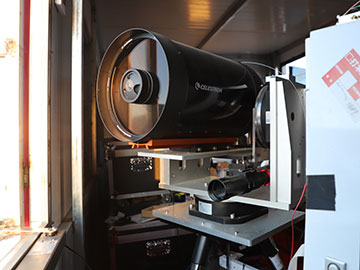
This image shows the experimental hardware for the study, including a telescope and camera. [Image: Zheng-Ping Li et al.]
In recent years, scientists have developed single-photon lidar as a tool for high-resolution mapping and target recognition. However, efforts to extend this type of lidar’s range past a few tens of kilometers have stalled due to near-field backscattering and high background noise.
Now a team at a Chinese university has developed a single-photon lidar system that can produce a 3D image of a target just over 200 km away (Optica, doi: 10.1364/OPTICA.408657). The researchers attribute the feat to a new noise-suppression technique and high-efficiency optical components.
Off-the-shelf components
At first glance, the experimental lidar setup built at the University of Science and Technology of China (USTC) might look like an astronomy project. The USTC scientists mounted a commercially available Cassegrain telescope with a 280-mm aperture to a sturdy tabletop platform. The light pulses for the lidar came from an erbium-doped fiber laser operating at 1550 nm, chosen not for its telecommunications usefulness, but for eye safety and good atmospheric transmittance, as well as low background noise from sunlight. The researchers changed the telescope’s optical coatings from the usual, which are optimized for visible light, to a combination of silicon dioxide and a type of gallium oxide, optimized for near-infrared wavelengths.
To process the incoming light, the USTC team devised a single-photon avalanche diode detector (SPAD) made from indium gallium arsenide and indium phosphide and cooled to 173 K. The cooling decreased the systems dark count rate about 20 times lower than other single-photon lidar systems, according to the authors.
With the efficient SPAD, the researchers found two sources of backscattering noise: the near-field atmosphere and amplified spontaneous emission (ASE). The noise-suppression technique the team developed to counteract these sources involves millisecond-scale temporal filtering. During the “emission mode,” the laser fires off its pulses while the SPAD shuts off. In “detection mode,” the SPAD switches on and the laser turns off. An acoustic-optic modulator filters out the ASE, which occurs during both modes.
Distant mountain views
To test out the system, the USTC researchers collected 3D images of objects over increasingly long distances: 9.8 km, 124 km and 201.5 km. For the last experiment, the team placed the lidar system in a temporary lab building at an altitude of 1770 m and imaged a distant mountain peak approximately 4500 m high. To the team’s knowledge, this is the first single-photon terrestrial lidar that can image a target more than 200 km away.
According to Feihu Xu, one of the USTC team leaders, the researchers’ next goal is to increase the speed of their single-photon imaging technique by using SPAD arrays. They hope that their system can be adapted for satellites for practical, low-power lidar applications.
The 12 scientists who performed the study are also affiliated with the Shanghai Research Center for Quantum Sciences, China.
